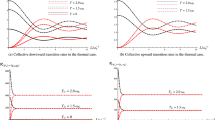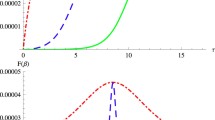Abstract
In this work, we study the behaviour of two weakly coupled quantum systems, described by a separable density operator; one of them is a single oscillator, representing a microscopic system, while the other is a set of oscillators which perform the role of a reservoir in thermal equilibrium. From the Liouville-Von Neumann equation for the reduced density operator, we devise the master equation that governs the evolution of the microscopic system, incorporating the effects of temperature via Thermofield Dynamics formalism by suitably redefining the vacuum of the macroscopic system. As applications, we initially investigate the behaviour of a Fermi oscillator in the presence of a heat bath consisting of a set of Fermi oscillators and that of an atomic two-level system interacting with a scalar radiation field, considered as a reservoir, by constructing the corresponding master equation which governs the time evolution of both sub-systems at finite temperature. Finally, we calculate the energy variation rates for the atom and the field, as well as the atomic population levels, both in the inertial case and at constant proper acceleration, considering the two-level system as a prototype of an Unruh detector, for admissible couplings of the radiation field.


Similar content being viewed by others
References
T. Matsubara, Prog. Theor. Phys. 14, 351 (1955)
J. Schwinger, J. Math. Phys. 2, 407 (1961)
L. Keldysh, Eksp. Teor. Fiz. 47, 1515 (1964)
Y. Takahashi, H. Umezawa, Collect. Phenom. 2, 55 (1975). reprinted in Int. J. Mod. Phys. B 10, 1599 (1996)
H. Umezawa, H. Matsumoto, M. Tachiki, Thermo field dynamics and condensed states. North Holland (1982)
J. Kapusta, C. Gale, Finite-temperature field theory: principles and applications. Cambridge Univ Pr (2006)
A. Das, Finite temperature field theory. World Scientific (1997)
F.C. Khanna, A.P.C. Malbouisson, J.M.C. Malbouisson, A.E Santana, Thermal quantum field theory: algebraic aspects and applications. World Scientific Pub Co Inc (2009)
J.L. Tomazelli, L.C. Costa, Int. J. Mod. Phys. A. 18, 1079 (2003)
H. Umezawa, Advanced field theory: micro, macro, and thermal physics. Amer Inst of Physics (1995)
S. Hawking, Commun. Math. Phys. 43, 199 (1975)
S.W. Hawking, Nature. 248, 30 (1974)
P.C.W. Davies, J. Phys. A: Math. Gen. 8, 609 (1975)
W.G. Unruh, Phys. Rev. D. 14, 870 (1976)
P.C.W. Davies, Reports Progress Phys. 41, 1313 (1978)
D. Sciama, P. Candelas, D. Deutsch, Adv. Phys. 30, 327 (1981)
N.D. Birrell, P.C.W. Davies, Quantum fields in curved space. Cambridge University Press (1982)
B. DeWitt, Phys. Rep. 19, 295 (1975)
J. Audretsch, R. Müller, Phys. Rev. D. 49, 4056 (1994)
J. Audretsch, R. Müller, Phys. Rev. A. 52, 629 (1995)
C. Cohen-Tannoudji, J. Dupont-Roc, G. Grynberg, Atom-photon interactions: basic processes and applications. Wiley (1992)
G.W. Ford, J.T. Lewis, R.F. O’Connell, Phys. Rev. A. 37, 4419 (1988)
J.J. Halliwell, T. Yu, Phys. Rev. D. 53, 2012 (1996)
G.W. Ford, R.F. O’Connell, Phys. Rev. D. 105020, 64 (2001)
B.L. Hu, J.P. Paz, Y. Zhang, Phys. Rev. D. 45, 2843 (1992)
W.G. Brenna, R.B. Mann, E. Martin-Martinez, arXiv:1504.02468 (2015)
Author information
Authors and Affiliations
Corresponding author
Appendices
Appendix A: The Coarse-Graining Approximation
In Section 3, the operator σ A (t ″) has been replaced by σ A (t), which is equivalent to expanding the master equation only to second order. If applied recursively, this procedure will generate contributions to higher orders, appearing terms of the type triple, quadruple commutators, and so on. The formal convergence analysis of this series is of extreme complexity, being out of the scope of this paper. However, we present elements of plausibility, which indicate that, at least, the series should asymptotically converge. The exact expression for the population is
Integrating the equation for ρ between t and t ″,
and substituting in the above equation naturally gives rise to the second and third order terms in the expansion,
Due to the shape of the potential, we find that the traces can be factored into a part referring to the system A and the other, g(τ), to the system R . This will allow us to ignore the higher order terms. We must show that, after a time interval Δt sufficiently large, the three points correlation of the reservoir observable are more strongly suppressed. Projecting on the R basis we have
We cannot go further without additional information about the reservoir. However, the reservoir has dense, almost continuous, spectrum of energy so we assume that the different phases in g(t ′, t ″) cause a destructive interference as time increases. Thus, g(t ′, t ″) oscillates very rapidly and its contribution to the integral becomes smaller. Considering two different time scales, such that
where τ c is the time correlation between observables of the reservoir and T A the time evolution associated with the microscopic system, we have at second order,
close to a given dominant frequency
In the expression, v≡〈V(β)〉 is the typical value of the interaction potential at equilibrium, the observable microscopic system is taken at a given time, around which it does not vary appreciably within the integration intervals. Performing the integral
therefore,
implying
To third order, we have
resulting
Then, in weakly coupled systems, the contribution of higher order terms is less than the lower order ones, even though the series does not converge uniformly, being only asymptotic.
Appendix B: Derivative Coupling
In this appendix, we ask ourselves what could happen if instead of (50), we had a derivative coupling. Thus, we propose a more general interaction given by
where the constant \({\omega _{0}^{n}}\) is introduced to ensure the correct dimension. With the interaction (115), we find new equations for the vacuum fluctuations and radiation reaction, equivalent to the (77) and (78),
Choosing the symmetrical order, \(\lambda =\frac {1}{2}\), we eliminate the divergences both in (116) and (117) . Then, by solving the integrals present in (116) and (117), we recover (80) and (81) for the non-derivative case. We thus observe that both results are independent of the coupling order, always giving the same energy variations.
Appendix C: Field Energy Variation
In Section 3.2, we derived an equation for the energy variation rate of the atomic system due to vacuum fluctuations and radiation reaction. In this appendix, we show that the energy balance is respected, observing that the energy variation of the field is equal, in module, to that of the atomic system. We start from the Heisenberg (53)
As previously said, it is advantageous to symmetrizing the operators in the evolution equation,
We separate again the free of the field responsible for the vacuum fluctuation,
as well as the interaction part, responsible for the radiation reaction,
Taking the expectation value in the field vacuum |0〉 and the atomic state |a〉, we obtain
where we can recognize the correlation functions and susceptibility (67), (68), (69), and (70),
Finally, replacing the functions found for C A, C F, χ A and χ F, for the asymptotic case, τ 0 → −∞, results
solving the integrals, one finds the same absolute values, obtained in (80) and (81), ensuring that the energy balance is respected.
Rights and permissions
About this article
Cite this article
Tomazelli, J.L., Cunha, R.O. The Master Equation for Two-Level Accelerated Systems at Finite Temperature. Braz J Phys 46, 503–515 (2016). https://doi.org/10.1007/s13538-016-0437-0
Received:
Published:
Issue Date:
DOI: https://doi.org/10.1007/s13538-016-0437-0




